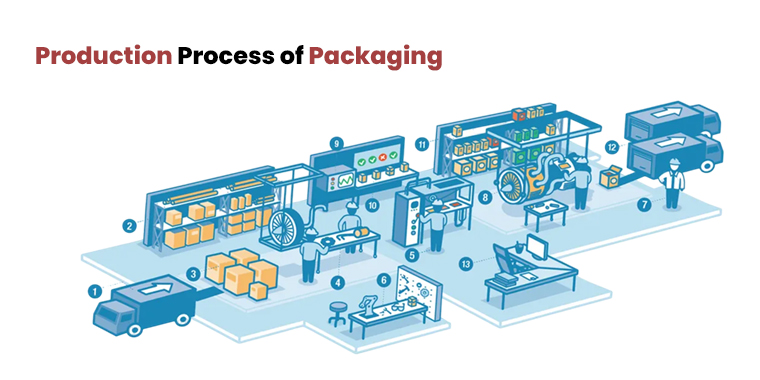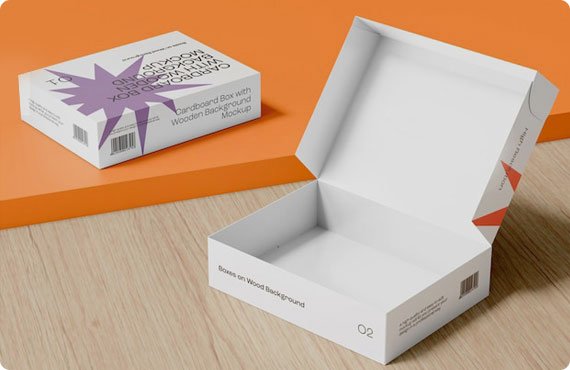April 24, 2025

Packaging is the first thing customers see when they buy a product. It protects the product, enhances branding, and influences purchasing decisions. A well-designed package ensures that a product reaches customers in perfect condition.
The packaging production process is a step-by-step journey that starts with an idea and ends with a fully functional, visually appealing package. Packaging is considered good if it fulfills the four rules of packaging. These are:
Every industry has unique manufacturing and packaging requirements. For example, a food package needs to be airtight and safe for consumption, while an electronics package must protect against shocks.
In this blog, we’ll take a detailed look at how packaging is created, from processing and packaging to quality control, branding, and distribution. Let’s begin!

The process of creating top-quality packaging involves careful planning and testing. This makes sure that the package is both functional and attractive. The following are the steps involved in this process:
In this step, the goal is to create packaging that protects the product and also uplifts its charm. Businesses consider several key factors in this regard, such as:
Purpose – protection, branding, or both?
Target audience – Who’ll use the product?
Brand identity – How will it reflect your company’s values?
The design process also includes:
A good package must be functional for the manufacturer and the consumer, as well.
The right materials are important because they affect the durability and cost of packaging. Various materials are available in the market. Some of them include:
Cardboard & Paperboard – These are lightweight and affordable. This makes them perfect for food and retail boxes.
Plastic – It is versatile and durable. But people are replacing it with greener options.
Glass & Metal – These are used in the food packaging production process for beverages and canned foods.
Biodegradable Materials – They are growing in popularity due to the increasing demand for sustainable packaging.
The packaging process of food products requires materials approved by the FDA. These are safe for direct contact with edibles. The right choice of material also reduces costs and improves efficiency in manufacturing and packaging.
Before mass production begins, packaging must be tested so that it meets industry standards. This is where businesses consider the five requirements of packaging, which are:
To test these factors, companies create prototypes and conduct various tests, such as:
A well-tested package ensures customer satisfaction and prevents costly errors in production.
Branding and visual appeal are important, as packaging serves as the first point of interaction between customers and your brand. This step, which involves printing, takes care of branding and visual appeal.
Common printing methods include:
Offset Printing – This method is best for high-volume production.
Flexographic Printing – it is affordable and perfect for bulk orders.
Digital Printing – This technique is ideal for small batches.
This stage also involves adding necessary details like:
The actual manufacturing and packaging process varies depending on the type of packaging. Some key steps include:
Die cutting – Shaping the material into the required design.
Folding & Gluing – Assembling different parts to form a structure.
Lamination & Coating – Adding layers to improve durability.
Packaging is incomplete without a quality check. Every package must go through testing to meet the required standards. Some key factors in this step include:
Quality control also ensures adherence to the four C’s of packaging. These are:
Cost-Effectiveness – The materials and design should be budget-friendly.
Convenience – The packaging must be user-friendly.
Communication – Important product details should be clear.
Compliance – The packaging must meet all the industrial requirements.
Failing to meet these standards can lead to customer dissatisfaction.
Once the packaging has passed all tests, it is ready for distribution. Efficient logistics ensure that products reach stores and customers in perfect condition.
The seven layers of packaging provide extra protection during shipping. These layers range from primary packaging (the packaging directly holding the product) to tertiary packaging (bulk packaging used for large-scale transport).
Smart packaging solutions, such as tamper-proof seals and waterproof labels, are now being used to improve security and customer engagement.
Also Read: How Proper Packaging Inventory Management Saves Time & Money
The process of packaging production is complex but necessary for success. Each step ensures that the final product is attractive and functional.
At Custom Designs Boxes, we provide excellent packaging solutions customized for your requirements. If you even need eco-friendly options, we’ve got you covered.
Contact us today via email at sales@customdesignsboxes.com to bring your packaging ideas to life!
Find the perfect packaging solutions tailored to your industry niche.
Don't just imagine – experience excellence up close, as you can check our superior craftsmanship before making your decision by ordering your sample kit.
